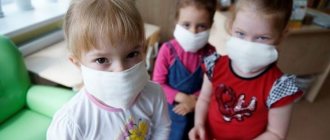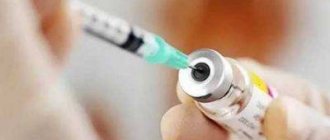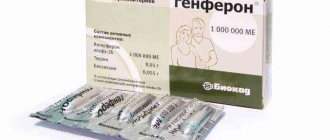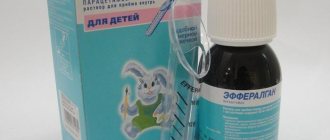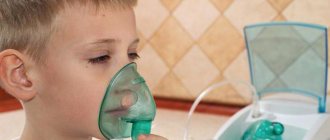When should children's fever be brought down?
Not all parents know when to lower their child’s temperature. The causes of fever can be associated with chronic or acute diseases, with improper functioning of the endocrine and nervous systems, it can also be ordinary overheating or a reaction to a vaccine.
In any case of detection of any excess of the temperature norm, it is necessary to contact a pediatrician to determine the causes and prescribe appropriate treatment. You cannot neglect the child’s health and treat the disease yourself.
When is it necessary to reduce the fever? All children individually relate to increased body temperature. Some people behave sluggishly at 37 - 37.5 C, they can fall asleep on the go or throw tantrums. Others, at 38.1 C, actively rush around the house and feel good.
It is important to remember : at 38 C, the body begins to independently fight the disease, producing interferon and increasing immunity. It is not worth reducing the temperature to 38.4 C. Give your child plenty of fluids.
At elevated temperatures, there is a better chance of defeating a viral infection than by knocking it down. The process of fighting immunity in this case will be considered natural.
Emergency conditions
Sometimes, at elevated temperatures, the baby’s condition can cause concern. In such cases, there is no need to waste time and urgently call an ambulance.
Such situations include:
- convulsions;
- vomit;
- diarrhea;
- after relief of symptoms, their sharp deterioration;
- lack of urination;
- lack of tears when crying;
- labored breathing;
- abdominal pain;
- rash on the body.
What to do if the temperature is more than 38.5 C?
At high temperatures, convulsions may begin. This cannot be allowed. It is recommended to bring down the body temperature to 38.5 C. In infants, temperature balance follows at night.
A temperature of 37.5 C in case of nervous or endocrine diseases can aggravate the situation, so it must be brought down from this level. Also, seizures with the same column require quick measures.
Any parents should have a printed reminder sign on hand. It will indicate the child’s age, at what point to start lowering the temperature and what to do.
| Age | t, C | Actions |
| 3 months - 1 year | up to 38.5 | Give your child plenty of fluids. If the temperature is accompanied by crying or hysterics, calm the baby down. Rock him in your arms, he needs your affection and care. The room where you will be with your child should be ventilated. Don't overdress your baby to prevent overheating. |
| from 38.5 | Give your baby an antipyretic. From 3 months you can use Nurofen and Paracetamol in the form of syrup or suspension or Cefekon in suppositories. They perfectly reduce the temperature and also have an analgesic effect. Keep feeding your baby. Call a doctor at home. | |
| 2 years or more | up to 38.5 | Give your child plenty to drink. This can be clean water, tea with raspberries, viburnum or currants, or rosehip decoction. If there is any lethargy or pain, call your doctor. |
| from 38.5 | Give an antipyretic and continue to give the child plenty of water. Call the doctor. |
At any age, it is necessary to monitor temperature fluctuations. Do not forget that rubbing with alcohol and vinegar is contraindicated for any age group. The dosage should correspond to the weight and age of the child.
It is convenient for children under 3 years of age to give medications in the form of syrup or suspension. Candles are not inferior in efficiency and convenience. Older children can be persuaded to take pills.
Under no circumstances should you prescribe medications to your child yourself.
Human temperature is divided into several groups. Each has its own characteristics. This:
- 37 - 38 C – low-grade fever. The temperature at these marks is not reduced. At this time, the body begins to fight infectious pathogens.
- 38 - 39 C – febrile. During this period, it is necessary to monitor the child’s condition and give him plenty of clean liquid. If the baby is in a calm state, the temperature can not be lowered. If the condition is accompanied by lethargy, headache or convulsions, then give an antipyretic.
- 39 - 40 - pyretic. This temperature indicates that the immune system cannot cope with the disease. It is necessary to give medicine and call a doctor. Negligence can lead to deterioration of the condition, seizures, and nervous system disorders.
- 41 and above – hyperpyretic. Dangerous temperature. The child's life and health are in danger. Call an ambulance urgently.
When should antipyretics be given?
All children react differently to high temperatures. Most children from the second half of the year to 4-5 years remain cheerful and active at a temperature of 38.5 ° C and above, some feel worse already at 37.1-37.5 ° C. In addition, the temperature reaction of each child, even at subject to the same reasons that caused it, individual. You should not lower the temperature if it does not exceed 38.5 ° C. Many parents know this statement from doctors, however, when they see a large number on the thermometer, they still get scared.
To make it easier for you to remain calm, know that at a temperature of 38 ° C the body begins to produce interferon - an immunity factor that has a powerful antiviral effect. The higher the temperature, the more its amount is produced in the body. Therefore, if the child tolerates the elevated temperature well, and you can control his condition, do not interfere with the natural healing process. By doing this, you increase the chance of a speedy recovery for the child and reduce the likelihood of complications. However, it is quite obvious that these tips are not useful for every child.
If you put your child to bed at night and the temperature rises to 38 C, it is advisable to give the child an antipyretic or reduce the temperature in other ways, since it will be very difficult to control the situation at night.
What forms of antipyretics are there?
Pharmacies are simply filled with various advertised and not so advertised drugs. What types of fever reducers are there? The choice is quite large. When choosing one of many, it is worth taking into account the age category of the child, his tendency to allergies and the active substance.
Basic forms:
| Form | Who is it suitable for? | How does it work? | Example of a drug |
| Suspension, syrup | Children under 12 years old | Liquid medicine is given with a measuring spoon or measuring syringe. They are included with the drug. It is absorbed into the walls of the gastrointestinal tract and begins to act after 20 minutes. Be careful when choosing a flavor, as your baby may be allergic to the flavoring. | Nurofen, Ibufen, Panadol, Paracetamol, Calpol, Efferalgan, Dafalgan, Dolomol, Meksalen |
| Rectal suppositories | Infants up to one year and 3 years | After administration, the drug begins to work after 40 minutes. Convenient to use before bed or during vomiting or regurgitation. Long-acting drugs. | Panadol, Tsefekon D, Efferalgan, Nurofen, Viburkol, Dafalgan, Dolomol, Meksalen |
| Tablets, lozenges | Use is allowed at an age when the child can swallow tablets or does not refuse them due to bitterness. | When taking tablets, you need to drink them with plenty of water. You can give the medicine first by crushing it and dissolving it in water. | Paracetamol, Ibuprofen |
How long after taking medication should the temperature drop?
Usually within 30-40 minutes, but sometimes longer. Do not wait or try to quickly lower the temperature or normalize it. It is enough for the mercury column of the thermometer to drop to 38 ° C or 0.5-1 ° C from the previous measurement. It is advisable that this be done gradually, since a rapid decrease in temperature to which the body has already managed to adapt can be dangerous for the child’s health.
If you have given your child medication, try to create comfortable conditions for him: change his clothes, provide access to fresh air and an appropriate temperature in the room (20-22 ° C).
Be prepared for the fact that the temperature may rise again within 3-4 hours, since antipyretics do not affect the disease itself.
The best and proven medicines for fever in infants and from 1, 2, 3 years old
What medicine is the most effective? Below you will find medications for children and their dosage.
Attention : before use, consult your doctor and read the instructions!
Paracetamol based
Paracetamol helps reduce temperature during acute respiratory viral infections, flu, otitis media, toothaches and teething, and colds. Has an analgesic effect. Suitable for babies from 3 months.
Contraindications are: newborns (up to 3 months), sensitivity to certain components, including flavoring agents. Careful use. If you have diabetes mellitus or a predisposition to it, kidney and liver diseases, hepatitis and Gilbert's syndrome.
In case of incompatibility, anemia, rash, itching, and angioedema occur. An overdose of the drug is accompanied by nausea, pale skin, vomiting, and lack of appetite.
Syrups and suspensions begin to act 20 minutes after entering the gastrointestinal tract. Rectal suppositories reduce the temperature after 40 minutes.
| A drug | Form | From what age? | Average price, rub. | Dosage | Number of times per day |
| Tsefekon D | candles | From 1 month | 55 |
| 2 -3 times |
| Calpol | syrup | From 3 months | 90 |
| After eating, 2 hours later, up to 3 times |
| Paracetamol | suspension | from 1 month | 50 – 55 |
| No more than 4 times before meals |
| syrup | From 3 months | 95 – 100 |
| No more than 3 or 4 times before meals | |
| Panadol | suspension | From 3 months | 95 – 100 |
| Up to 3 – 4 times |
| candles | From 3 months | 85 – 95 | Use 1 suppository rectally for children under 3 years of age. | Up to 3 times | |
| Efferalgan | syrup | From 1 month | 100 | The syrup is poured into a measuring spoon at the indicated stroke, equal to your child’s weight category. Follow the instructions strictly. | No more often than every 6 hours |
| candles | From 3 months | 113 |
| No more often than every 6 hours |
Ibuprofen based
Ibuprofen helps replace medications that contain paracetamol, which does not help people or causes allergies. Ibuprofen-based drugs reduce fever and have an analgesic effect. Relieves toothache, headache and other types of pain.
You should not use such medications if you have problems with the blood, kidneys, liver, or hearing. The presence of allergic rhinitis, asthma, urticaria, gastrointestinal ulcers are also contraindications.
If the medicine is not suitable, you can observe:
- pain in the stomach;
- rash;
- diarrhea;
- nausea;
- vomiting;
- dizziness;
- headache;
- frequent urge to urinate;
- leukopenia;
- anemia;
- insomnia;
- bronchospasm.
Symptoms of overdose: low blood pressure, tinnitus, vomiting, abdominal pain, headache.
| A drug | Form | From what age? | Average price, rub. | Dosage | How many times a day? |
| Ibufen | suspension | From 6 months | 85 – 90 | If t is below 39 C:
| Up to 4 times |
If t is above 39 C:
| Up to 2 times | ||||
| Nurofen for children | suspension | From 3 months | 115 |
| 3 or 4 times |
| candles | From 3 months | 95 |
| 3 times | |
| 4 times | ||||
| Motrin for children | suspension | From 6 months (as prescribed by a doctor) |
| Up to 4 times | |
| 3 times | ||||
| 3 times |
Homeopathic medicines
Alternative medications for fever and pain include the homeopathic drug Viburkol. It has many components to provide antipyretic, analgesic and anti-inflammatory effects. Used during the treatment of respiratory diseases.
Available in the form of suppositories for rectal administration. Store in a cool place. The ideal temperature is 15 – 20 C.
Candles can be used during teething. The components relieve discomfort and pain. Opinions differ on whether the vaccine after vaccination is effective or not. Effectiveness is observed in children under one year of age.
| A drug | Form | From what age? | Average price, rub. | Dosage | How many times a day? |
| Viburkol | candles | From 1 month | Up to 6 months - 1 PC. | 2 times | |
| From 6 months - 1 PC. | 4 times (37.5); 6 times (38) |
Photo: Antipyretics for high fever in children
How often can antipyretics be given?
The general rule for taking antipyretics: they are not given to a child for the purpose of prevention, but are prescribed for elevated temperatures. The minimum break between taking medications that reduce fever should be 4-5 hours. But these issues must be discussed with the doctor who is observing the child. Frequent (more than 3-4 times a day) taking antipyretic drugs by a child leads to an increase in the daily dose and accumulation of drugs in the body, which can cause poisoning. In order for the medicine to be well removed from the body, it is necessary to drink a lot of fluid. It is very important to measure the temperature correctly. It is not recommended to do this while feeding the baby, immediately after sleep or active play - especially during the hot season.
If your child has a fever, and his condition does not improve when the temperature drops, he remains lethargic and inactive, do not rely on your knowledge, be sure to consult a doctor: since there is a high risk of complications (in particular, pneumonia), since respiratory viral infections (for with the exception of influenza) rarely cause intoxication.
When to call a doctor urgently?
It is necessary to call an ambulance urgently in cases where the child’s life is in danger and, in addition to temperature, the following are observed:
- convulsions;
- increase in temperature after taking the medicine;
- no cold symptoms;
- painful sensations in the abdomen;
- changes in breathing (faster, more difficult, or slower);
- dehydration;
- diarrhea;
- vomit;
- drowsiness;
- hemorrhages throughout the body;
- rash;
- deterioration of condition.
Remember that paracetamol preparations are safer and can be used to reduce fever in children from one month onwards. Less aggressive effect on the stomach. Valid for no more than 4 hours. While ibuprofen is stronger and works for up to 8 hours, it can upset the stomach and affect blood clotting.
Contact your pediatrician if your baby's temperature rises. Do not neglect your child’s health by self-medicating.
How often can antipyretics be given?

You should not hope that the temperature will immediately drop to normal values. Such jumps are harmful to the body.
The decrease will occur by 1-1.5°C and this is normal. If after some time the temperature rises again, then you need to wait at least 4 hours between antipyretic doses.
Preparations based on paracetamol and ibuprofen are compatible, so if the effect of one does not occur, then you can use the other one hour after taking the first. But the total amount taken per day should not be more than 4 times for each medicine.
Particular attention should be paid to measuring the child's temperature. Until now, according to many mothers, the best thermometer is a mercury thermometer, since it has the smallest error and is less likely to distort the measurement, unlike electronic and laser thermometers. But do not forget about safety precautions when using a mercury thermometer.
You should not take your temperature if your child:
- is eating or has recently eaten;
- cries;
- recently woke up;
- I recently played active games.
Taking the drug can be extended for more than 5 days, only with the approval of the doctor, since we are talking about the accumulation of the drug in the body, which can lead to intoxication. To ensure that the drug does not stay in the body for a long time, you need to give the child to drink more often.
How often can Nurofen be given to a child?
Doctors strongly recommend starting to give an antipyretic only after the body temperature has increased to 38.5 degrees. If the body temperature is lower, it is not advisable to give Nurofen to children. A temperature of 37 degrees or more is considered necessary to fight the body’s defenses against pathogenic infectious microflora. Pediatricians assure: this is how immune defense begins to form.
After giving the suspension to the child, you must wait at least 4 hours. In rare, special cases, only as directed by a doctor, the medicine can be given after 3 hours. As a rule, the child’s body temperature decreases within 4 hours. If there is no improvement, the temperature does not subside, you can give another antipyretic medication. The best combination of ibuprofen and paracetamol contained in children's Panadol. The use of Nurofen can be repeated after 6 hours, but no more than 3 times a day.
It is prohibited to use Nurofen suppositories after 4 hours after syrup, as this can cause an overdose and the development of complications.
The use of other medications combined with ibuprofen requires consultation with your doctor. This is due to the fact that the interaction of Nurofen with other anti-inflammatory drugs can cause unexpected reactions in the child’s body.
